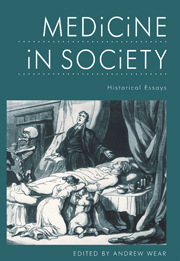Book contents
- Frontmatter
- Contents
- List of contributors
- Introduction
- Healers in the medical market place towards a social history of Graeco-Roman medicine
- Medicine and society in medieval Europe, 500-1500
- The patient in England, c. 1660–c. 1800
- Making sense of health and the environment in early modern England
- Medicine in the age of Enlightenment
- The rise of the modern hospital in Britain
- Medical practitioners 1750–1850 and the period of medical reform in Britain
- Public health, preventive medicine and professionalization: England and America in the nineteenth century
- Madness and its institutions
- From infectious to chronic diseases: changing patterns of sickness in the nineteenth and twentieth centuries
- Providers, ‘consumers’, the state and the delivery of health-care services in twentieth-century Britain
- The implications of increased life expectancy for family and social life
- Index
Medicine and society in medieval Europe, 500-1500
Published online by Cambridge University Press: 13 January 2010
- Frontmatter
- Contents
- List of contributors
- Introduction
- Healers in the medical market place towards a social history of Graeco-Roman medicine
- Medicine and society in medieval Europe, 500-1500
- The patient in England, c. 1660–c. 1800
- Making sense of health and the environment in early modern England
- Medicine in the age of Enlightenment
- The rise of the modern hospital in Britain
- Medical practitioners 1750–1850 and the period of medical reform in Britain
- Public health, preventive medicine and professionalization: England and America in the nineteenth century
- Madness and its institutions
- From infectious to chronic diseases: changing patterns of sickness in the nineteenth and twentieth centuries
- Providers, ‘consumers’, the state and the delivery of health-care services in twentieth-century Britain
- The implications of increased life expectancy for family and social life
- Index
Summary
The hallmarks of medieval medical care were its variety and its intensity. Our own society boasts a relatively small (although growing) range of both medical institutions and publicly recognized medical practitioners, narrowly defined, similarly trained, and socially homogeneous. Medieval society, on the other hand, like many present-day traditional societies, looked to a much broader set of healers and strategies to care for its precarious health. In part this situation reflected much higher levels of illness than we are used to – levels that sprang from extensive poverty and unhealthy living conditions as much or more than the limits of medieval therapeutics. In part it reflected the variety of medieval society itself. A millenium separated the Europeans of 1500 from their counterparts in 500, and that millenium encompassed changes arguably far more radical than those of the five centuries that separate us from them. Furthermore, Europe was much more diverse then than now, when advances in transportation and communication and other social shifts have acted to homogenize institutions and to break down cultural and linguistic barriers between nations, between city and countryside, between rich and poor.
For these reasons, historians have tended to describe medieval medicine as a dense set of discrete forms of theory and practice tenuously related – if related at all – whose principles frequently contradicted one another and whose practitioners rarely overlapped: physic and surgery, academic medicine and empirical medicine, rational medicine and magical medicine, men's medicine and women's medicine, religious medicine and secular medicine, medicine of the rich and medicine of the poor.
- Type
- Chapter
- Information
- Medicine in SocietyHistorical Essays, pp. 59 - 90Publisher: Cambridge University PressPrint publication year: 1992
- 18
- Cited by



